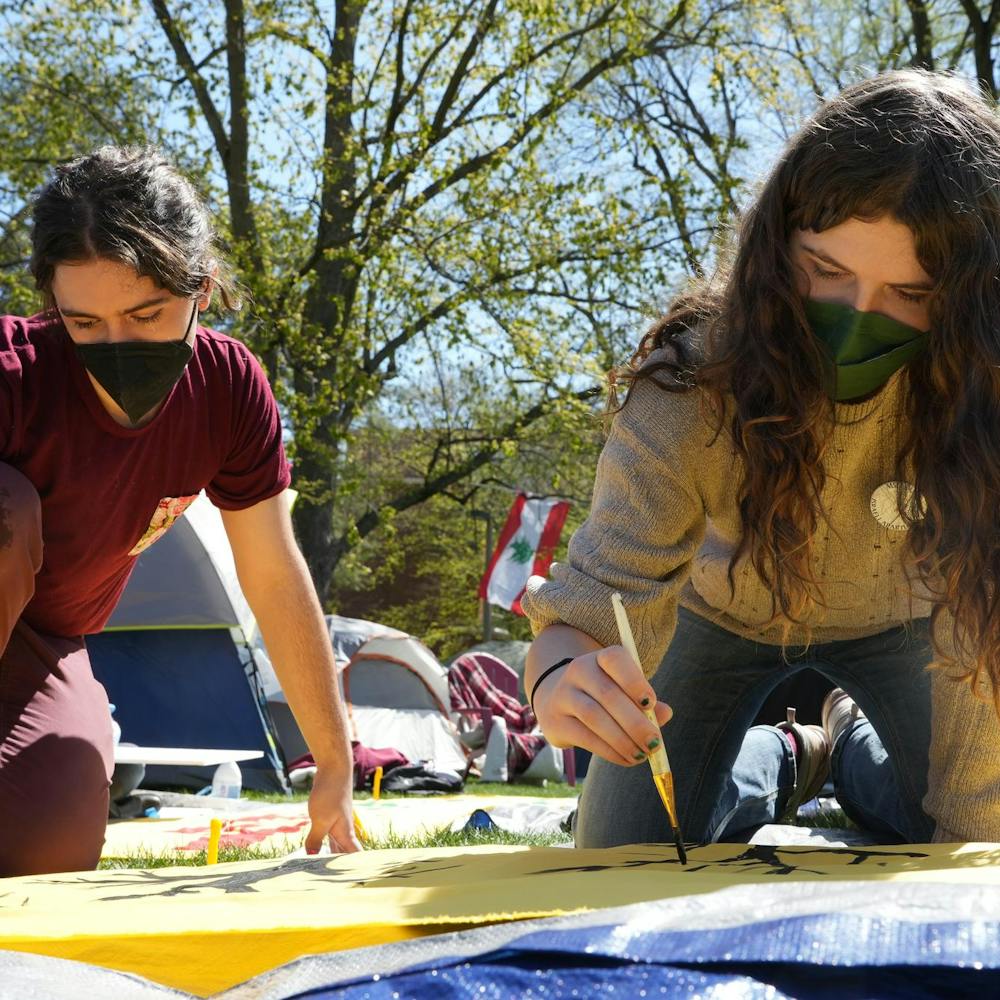At first glance, the dentist’s chair, the Sharps container on the wall and the spotless floor of Greg Drake’s workroom might appear to be a medical office.
But a closer look reveals M.C. Escher drawings, Salvador Dali paintings and signs with sayings such as “Tipping is good karma!” covering the walls. Tape hides a rip in the chair’s arm, and heavy metal fills the room.
“Doctors and nurses from hospitals and emergency rooms have said, ‘You’re as clean as us,’” says Drake, a tattoo artist who works at Splash of Color Tattoo & Piercing Studio, 515 E. Grand River Ave.
Drake is covering all cords and surfaces with plastic to get ready for his customer.
“It’s a barrier because we use this stuff on everybody,” he says. “It cuts down on cross-contamination.”
As he covers the old dental chair with paper - just like doctors do - Drake explains that needles are never used more than once.
“We throw the whole needle away - it’s a lot safer for the artist and a lot safer for the customer,” he says. “The tube (that holds the needle) is the only thing that doesn’t get thrown away.”
Drake has a skeleton of a gecko tattooed on one side of his neck and “tattoo artist” in Japanese on the other. His arms are covered with skull- and Asian-themed tattoos.
He walks to get his customer, who is waiting in the studio’s lobby with the piece of paper on which Drake drew her design: airborne wings. Although Drake has done the tattoo of a parachute flanked by two wings before, he drew it to make sure it is exactly how she wants it.
“They always want it in different ways, so that’s the good part about it,” Drake says. “They always have some special way they want it done, whether it’s all black or with colors.”
Moneeka Mayo, a political economy senior, wants her wings black with shadows and tattooed on her lower back.
“I want it low enough where my underwear might cover it,” she says as she enters the room.
Lower back tattoos are the most popular among females, tattoo artist Sean Peters said.
“We’ve gotten more females in the last year or two,” he said.
Mayo’s two friends try to reassure her as she glances at the needle.
“It looks like this might be slightly painful,” she says as she lowers her pants and lifts up her shirt.
Drake says it’s rare for a customer to come alone.
“Usually they bring friends for support and usually their friends have gotten it done,” he says as he shaves the area where he will apply the tattoo.
“You always have to shave the skin or you get ingrown hairs,” he says as he puts soap on the area. “Plus, the hairs will get in the way.”
He places the design, which is on special paper with regular ink on one side and purple on the other, on Mayo’s lower back. The purple ink temporarily stains the skin when he puts the paper against it. The paper can be used multiple times if the customer isn’t happy with the positioning.
Mayo approves the spot. Drake puts on a pair of rubber gloves, then turns on the machine - it starts buzzing, sounding like a dentist’s drill.
“This is about to hurt,” Mayo says.
“No, it’s not - it’s going to be OK,” Drake answers.
Mayo sits in the chair.
“Just try to breathe for me - don’t hold your breath,” he says, adding that he often has to coach customers through the process.
“I have to keep telling them, ‘You’re all right,’” he says as he starts to draw the outline of the left wing.
“I normally do the outline first, then the shade work or any color work.”
Mayo starts shaking. “You’ve really got to relax for me,” Drake says.
The needle that cuts the skin is razor sharp, he says. It is held in a tube filled with ink.
“The needle rides back and forth in the tube so when it touches the skin, the ink comes out of the tube,” Drake explains. “It goes real fast so it’s cutting, but it’s real precise and controlled.
“All I do is act like I’m drawing.”
But it’s a lot tougher to draw on skin than on paper, he says. That’s why he tries to draw each design four or five times before doing the tattoo.
After each line, Drake wipes off the extra ink. “Do you want to do black shimmers or brown?” he asks after he finishes the outline and covers it with ointment to prevent bleeding.
“Black,” Mayo says.
“It feels like a cat walking up and down your back,” she says as Drake draws the shimmers. “I thought it would kill me.”
Mayo, one of only two MSU female students to earn airborne wings as a paratrooper in the Army last summer, says she wants the tattoo to commemorate her achievement.
“It’s a pride thing - once you have it, you always have it,” she says. “It’s something I’m really proud of - and I don’t know another girl who has her wings tattooed on her.”
Kris Lachance-Peters, owner of Splash of Color, said people get tattoos for a number of reasons.
“We had one girl come in who had been molested by her father and wanted to get a tattoo to reclaim her body,” she said. “And once we had eight people come in after a funeral to get tattoos as a memorial to the person who died.”
The amount of people who get tattoos has grown dramatically in the past few years, Sean Peters said.
“It’s more acceptable - there’s more liberty to do it now,” he said. “A few years ago, you thought of tattoos and you thought of bikers. We’ve moved into a whole new realm now.”
To make the shimmers, Drake fills the tube with a full cap of water, adding one drop of ink to make a gray color. When he finishes the tattoo, he wipes it with surgical soap to clean all excess blood off the skin.
He adds more ointment, which, combined with the soap, contains the blood so it won’t run down the skin. The tattooing process only produces a small amount of blood.
Drake puts a square chunk of absorbent gauze over the tattoo and places plastic wrap over it, which should stay on for about an hour.
“Anything over an hour is basically smothering it,” Drake says as he puts the needle in the Sharps container. He gives Mayo a packet of ointment, vitamins A and D, and Tattoo Goo - a special substance to help heal the tattoo. He explains that she should apply thin coats of the ointment and vitamins for two days, then hand lotion or the Tattoo Goo.
Drake, who usually works on three to five customers a day, says the average tattoo takes about an hour, although he has spent up to eight hours on one tattoo.
“I usually tackle the larger ones for a couple hours, take a break and jump right back on another one,” he says. “Sometimes I’ll finish it another day.”
After Mayo - Drake’s last customer of the day - signs a release form, Drake throws away all the plastic and paper he used to cover everything up. He takes the needle’s tube to the sterilizing room, where it will go through a long process of getting sanitized.
“Sometimes I won’t get the tube back for a couple of days,” he says.
Lachance-Peters said Splash of Color works hard to keep everything clean and safe. All the employees have to take an anatomy course, a blood borne pathogen course and a first aid and CPR course before working at the studio. The blood borne pathogen, first aid and CPR courses must be updated annually, she said.
“There’s the artistic end and then there’s the technical end of it,” she said. “It’s no different than going into a doctor’s office or a dentist’s office, where there’s blood.”
Lachance-Peters belongs to Health Educators Inc., a group that tries to educate people in the tattoo business about safety and safe techniques. She also works with lawmakers to come up with legislation for the occupation.
“We’re working in an industry that is so heavily unregulated,” she said. “We need to better the industry and take it to that next level.
“We deal with blood and bodily fluids, and with hepatitis and tuberculosis back in large portions, we have to be aware of the protocol that needs to be taken to prevent transmissions.”






